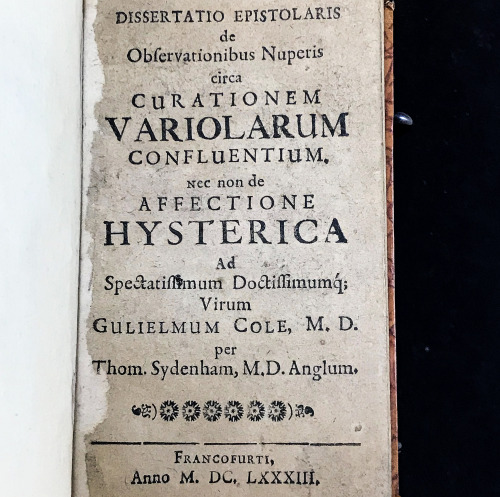In 1682, the physician Thomas Sydenham first published his observations on hysteria (along with conf
In 1682, the physician Thomas Sydenham first published his observations on hysteria (along with confluent smallpox) in London. Diagnoses of hysteria, a condition characterized by unrestrained emotion, had dated back to ancient Egypt and Greece. The disease derived its name from the Greek word ὑστέρα (transliterated as “hystera”), meaning womb, because the ancients believed this organ was uniquely responsible for emotional imbalance. For centuries, hysteria was considered a female illness. In the text featured here, Sydenham, considered the “Hippocrates of England,” defied traditional medical knowledge by arguing that all people, regardless of whether they had a uterus, could suffer from this condition. In fact, he argued that social status, rather than biological sex, was a greater determining factor for hysteria; emotional excess was more likely to be a problem for the wealthy and civilized. Sydenham’s studies were held in such esteem abroad that merely a year after the first English edition came out, a printer in Frankfurt, Germany, produced this duodecimo edition of Dissertatio epistolaris. The format is so small, it can easily be cradled in the palm of a hand or tucked away in a pocket for quick consultation. Luckily for us, we know a few details about the physician who used this particular book because he wrote a Latin inscription on the verso (a.k.a., the backside) of the title page. He was a medical doctor from Bremen, Germany, named D. Harmes. We can only hope that Dr. Harmes did not live up to his sinister-sounding surname and kept the Hippocratic Oath to “do no harm”! Images from: Sydenham, Thomas. Dissertatio epistolaris de observationibus nuperis circa curationem variolarum confluentium. Nec non de affectione hysterica. Frankfurt, 1683. Call number: RC183 .A2 S9 1683 Catalog record: https://bit.ly/3HA0UgS -- source link
Tumblr Blog : noelcollection.tumblr.com
#rarebooks#psychiatry#book provenance#paleography#hysteria

